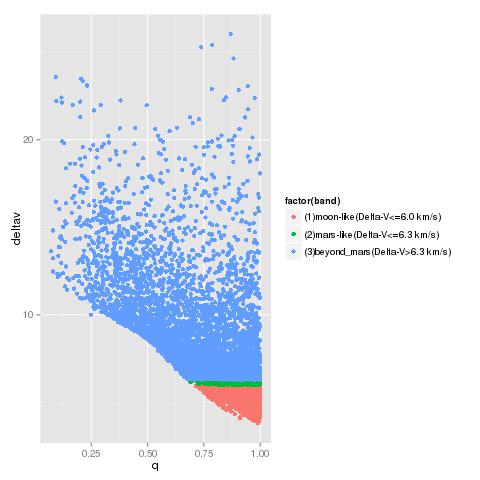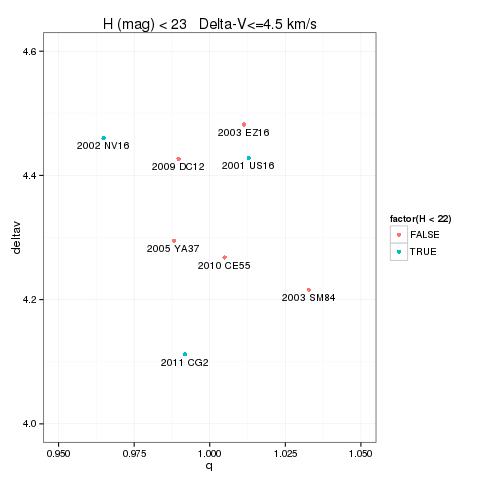JPL maintains an interesting list: Near-Earth Asteroid Delta-V for Spacecraft Rendezvous
Let's display how Delta-V depends on perihelium q=a*(1-e)
(Graphs are done with R package and the related ggplot function)
Neo with q <=1
Delta-V (km/s) vs q (AU)
delta-v = -7.3q + 11.4 when q<=1
Neo with q> 1
Delta-V (km/s) vs q (AU)
delta-v = 4.6q - 0.5 when q>1
Three "bands" for Delta-V
As stated in the JPL page, for comparison, Delta-V for transferring from Low Earth Orbit to rendezvous with Moon and Mars:
- Moon: 6.0 km/s
- Mars: 6.3 km/s
1) moon-like (Delta-V <= 6.0 km/s)
2) mars-like (Delta-V <= 6.3 km/s)
3) beyond-mars (Delta-V > 6.3 km/s)
Neo with q <=1
Delta-V (km/s) vs q (AU)
Neo with q > 1
Delta-V (km/s) vs q (AU)
We can look at the neo distribution in every Delta-V band:
Neo with q <=1
Ultra-low Delta-V Neo
I often read that these neo are considered as a particular interesting target for spacecraft rendezvous missions because very little energy is needed to reach them.
This is a graphical display for neo with Delta-V <= 4.5 km/s:
These ultra low Delta-V neo are just a tiny fraction of the neo population.
This is their proportion:
As known, one of the problems with these neo is that it is very difficult to find relative bright (and thus big) asteroids.
The graph below shows all the ultra low Delta-V asteroids with H (mag) <= 23 showing that only three neo of this group have H (mag) <= 22. They are:
| Designation | Delta-V (km/s) | H (mag) |
|---|---|---|
2011 CG2 |
4.112 |
21.5 |
2001 US16 |
4.428 |
20.2 |
2002 NV16 |
4.460 |
21.4 |
(1999 RQ36) Bennu and ("similar?") Neo
Delta-V for Bennu: 5.087 km/s
H (mag) = 20.9
See also:
http://en.wikipedia.org/wiki/101955_Bennu
http://astro.mff.cuni.cz/davok/papers/bennu_osiris_maps2015.pdf
If we give a look at asteroids having Delta-V and H at least comparable (or better) than those of asteroid Bennu, target of the OSIRIS-REx mission, we can find a few other ones.
Bennu is shown at the top-left corner of the image.
Bennu is shown at the top-left corner of the image.
Of course, Delta-V is not the only parameter used to decide whether an asteroid is a good candidate for a sample return mission (physical characteristics, a well known orbit and an appropriate rendezvous time are certainly other fundamental aspects!).
Once said this, I would be interested to know if some of the other asteroids shown here are candidates for similar missions.
In fact, I found an interesting link showing the earth-centric orbit view of many of these asteroids
In fact, I found an interesting link showing the earth-centric orbit view of many of these asteroids
Kind Regards,
Alessandro Odasso
















